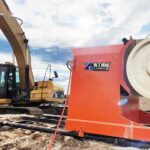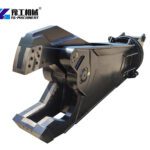Demolition shear is a hydraulic attachment mounted on excavators, cranes, or other heavy machinery, featuring a pair of jaws equipped with sharp, durable blades. These jaws open and close with immense force, enabling the shear to cut through metallic structures, scrap metal, and concrete. They are often used in environments where precision cutting is essential, such as in the dismantling of buildings, factories, or infrastructure like bridges and highways.
Key Features and Components
1. Blade Material and Design
High-carbon steel blades with heat treatment resist wear and maintain sharpness.
2. Hydraulic Efficiency
Advanced hydraulic systems with load-sensing technology optimize fuel consumption and reduce operating costs.
3. Safety Mechanisms
Features like overload protection, emergency stop buttons, and blade guards prevent accidents and equipment damage.
Applications of Demolition Shears
1. Structural Demolition
Shears excel at dismantling steel frames, concrete walls, and bridges, reducing debris to manageable sizes.
2. Scrap Processing
In recycling facilities, shears shred cars, appliances, and industrial scrap into recyclable metal.
3. Disaster Recovery
After earthquakes or fires, shears help clear debris safely and efficiently.
Advantages of Using Excavator Hydraulic Shears
1. Precision and Control
Unlike explosives or wrecking balls, demolition shear provide operators with unparalleled control. This precision minimizes the risk of unintended damage, making them ideal for projects in densely populated areas.
2. Efficiency
Hydraulic shear for excavator drastically reduces project timelines. Their ability to cut through materials quickly translates to lower labor costs and faster site clearance.
3. Safety Enhancement
By eliminating the need for manual cutting or hazardous explosives, demolition shear enhance workplace safety. Operators can maintain a safe distance from the demolition zone, reducing injury risks.
How to Select A Suitable Excavator Shear?
Choosing an appropriate demolition shear requires careful consideration of several factors:
1. Material Type
Different blades are optimized for specific materials. For instance, carbide-tipped blades excel in cutting reinforced concrete, while standard steel blades suffice for softer metals.
2. Machine Compatibility
The shear must match the host machine’s hydraulic flow, weight capacity, and mounting system.
3. Project Scale
Large-scale projects may necessitate high-cycle shears with rapid cutting speeds, whereas smaller tasks can utilize compact models.
Maintenance and Safety Practices
Regular Lubrication: Hydraulic components and pivot points require consistent lubrication to prevent wear.
Blade Inspection: Check blades for cracks or dullness. Sharpen or replace them as needed.
Hydraulic System Checks: Monitor fluid levels and inspect hoses for leaks.
Storage: Clean the shear after use and store it in a dry environment to prevent rust.



